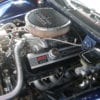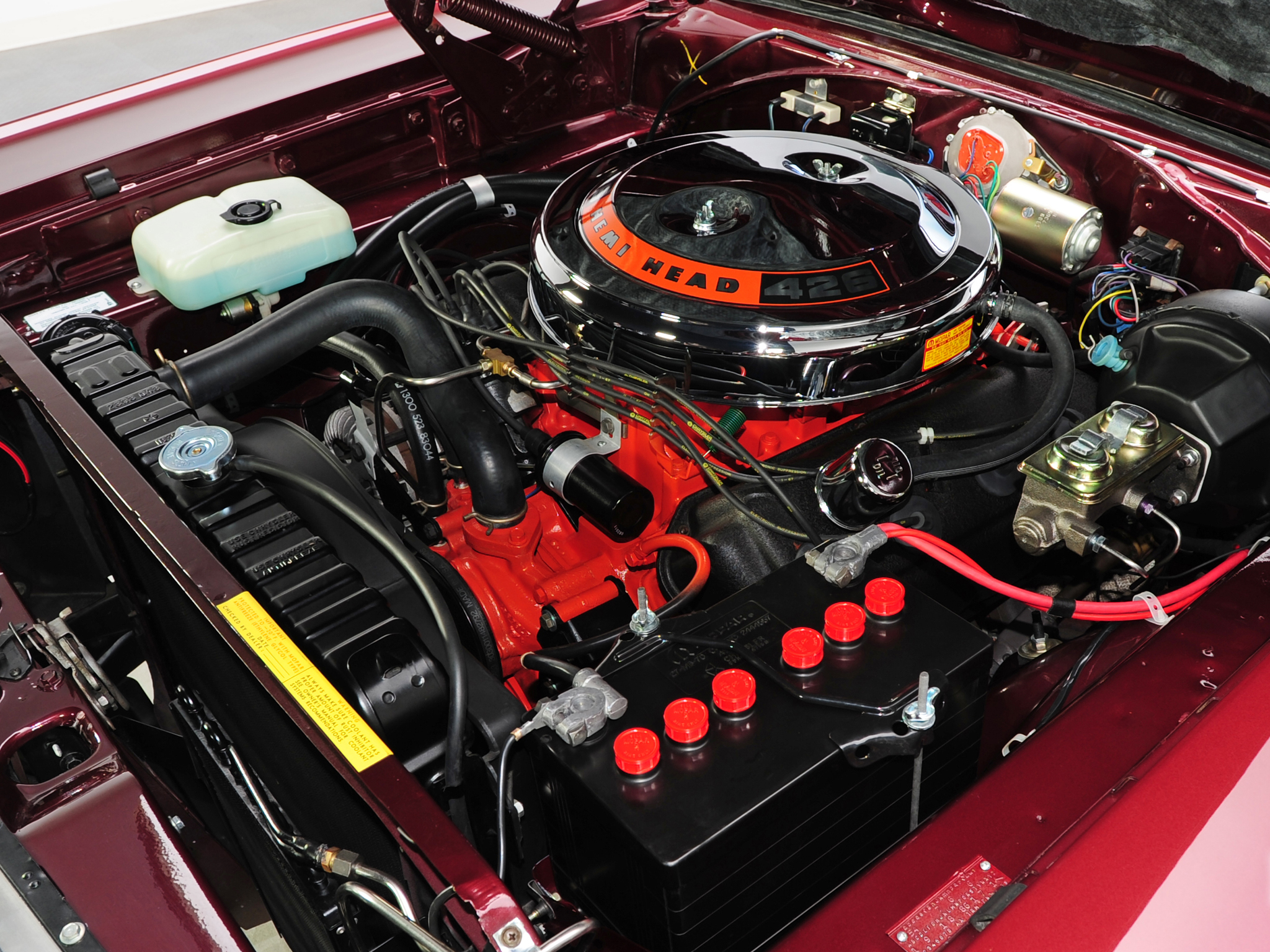The Mopar Hemi V8

MOPAR HEMI BACKGROUND
Like every other major manufacturer in America at the time, Chrysler was forced to suspend all civilian passenger car production starting in 1942 and continuing until the end of World War 2 in 1945. They built many things for the US war effort, among them aircraft engines. Many utilized hemispherical combustion chambers and valves that were angled toward each other, to achieve the thermal efficiency needed to make a good airplane engine. Chrysler was tasked with building the first hemi-head engine for the P-47 Thunderbolt, an experimental 2500-horsepower inverted V16 . While it never reached production, Chrysler’s engineers learned a lot during those years, developing and problem-solving on those giant engines. When civilian production resumed in 1946, no one was ready with new products, they warmed-over what they’d had in 1942. Once they got rolling, by the early 1950s styling was changing fast, and so did engine and transmission technology. GM trumped the market by introducing advanced OHV V8 engines in their Oldsmobile and Cadillac lines. Ford was still plodding along with the same ancient flathead V8 that The Old Man himself had created in 1932, still several years from their own OHV V8. Chrysler wanted to enter the V8 race with its own advanced OHV V8, so they dusted off all that old WW2 tech and decided to build a V8 with hemispherical combustion chambers and angled valves, just like the high-performance airplane engines that helped win the war.

WHAT IS A MOPAR HEMI?
While most American-made production V8s have all their valves (intake and exhaust) lined up in a straight line, which isn’t the best way to achieve efficiency, but its great for keeping production costs down. The nickname “hemi” is a shortened version of ‘hemispherical’, referring to the configuration of its combustion chamber. The hemispherical combustion chamber is just that: it’s a hemisphere, or half of a sphere. Inside, the two huge valves face each other at an included angle, in a ‘cross-flow’ design, that maximizes airflow into and out of the combustion chamber. The spark plug is centrally-located at, or near the top of the sphere, promoting a near-ideal flame front. This was complemented by a domed piston that was meant to fill the chamber at the top of its stroke, allowing almost any compression ratio. Further, there is less surface area relative to volume than other designs, which reduces heat loss, and improves thermal efficiency. The downsides were many: size, weight, complexity and cost. These were big, heavy engines with complex push rod-and-rocker arm systems needed to actuate those splayed valves, and that was expensive. Hence, Chrysler’s Hemi engines became their premium engine offerings, while offering simpler, cheaper V8s like everyone else was building as their base V8 engines.
1st-GENERATION MOPAR HEMI, “FirePower Hemi” 1951-1958
331 Cubic Inch (5.4L) “FIREPOWER HEMI”; 1951-1955
The first Mopar Hemi was the 331 cubic inch “FirePower Hemi” and was available on in Chrysler cars from 1951 through 1955. Most came with a single 2-barrel carburetor and made 180-horsepower. However, the most famous of the FirePower Hemis was found in the 1955 Chrysler C-300, the first of the legendary “Letter Cars”, where it sprouted two Carter WCFB 4-barrels, and produced 300 horses to match its name. 1st-gen Hemis came in two different deck heights, and the 331 used the 10.32-inch “low-deckblock”. The 331 FirePower Hemi has a bore of 3.8125″ and a stroke of 3.625″, barely oversquare, but typical for the times.
354 Cubic Inch (5.7L) “FIREPOWER HEMI”; 1956-1959
The 354 Hemi was released in 1956 using the same 10.32″ low-deck block and 3.625″ stroke. A 3.9375″ bore brought the extra displacement. In its first year, it was available only in Chrysler cars, but expanded into Dodge cars and trucks in 1957. In standard trim, the 354 made 280 horsepower with a single 4-barrel, but in the 1956 Chrysler 300B it was rated at 355 horsepower with dual 4-barrels, making it the first American V8 to make one horsepower-per-cubic inch. Starting in 1957 a special version optimized for heavy truck use was introduced as the Power Giant V8 and served as Dodge’s top truck engine through 1959. And as a means to bring the cost of these expensive engines down, Chrysler introduced a new set of cylinder heads in 1957 that featured “polyspherical” (ie: wedge) combustion chambers, which were both cheaper and lighter than the hemi heads. They produced the 354 in both configurations through 1959. As an interesting aside, when Dodge introduced its new 3rd-gen Hemi in 2003, its displacement was 5.7 liters, which is the same metric displacement as the 1st-gen 354 FirePower Hemi.
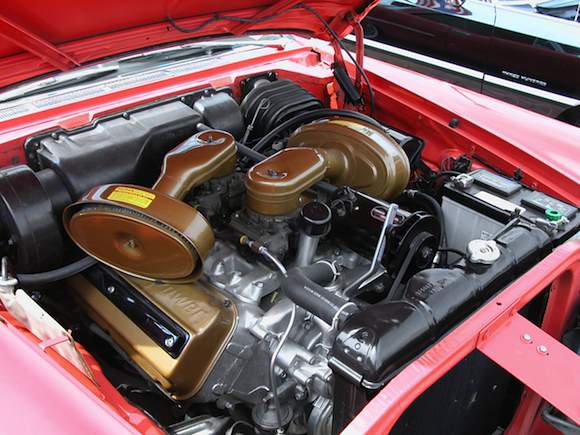
392 Cubic Inch (6.4L) “FIREPOWER HEMI”; 1957-1958
The 392 Hemi was the first raised-deck Hemi, which was needed for the new 3.906-inch stroke. It’s 4.00-inch bore made it just barely oversquare. The 392 was now the new premium V8 in Chrysler’s lineup and an option on Dodge cars and trucks. It came in two versions, one with a 9.25:1 compression ratio rated at 325hp, and the other with 10.0:1 compression rated at 345hp, both with single 4-barrel carburetors. The top-line 392 came in, you guessed it, the Chrysler Letter Cars, the 1957 300C and the 1958 300D, where it used dual 4-barrels to make 375 horsepower. An extremely rare option on the 1958 300D was a 392 with Bendix “Electrojector” fuel injection system, rated at 390hp. However, horrible reliability issues grounded the program after just 16 were produced. 15 of those were recalled and retrofitted with carburetors. That leaves just one…maybe. By the late 1950s drag racers had discovered the big 392 Hemi and were modifying it in every way possible to get more power out of it, keeping this 1st-gen Hemi competitive well into the 1970s. As an interesting side note, the metric displacement of the 392, which is 6.4 liters, is the same as the largest of the modern Hemis, also a 6.4L.
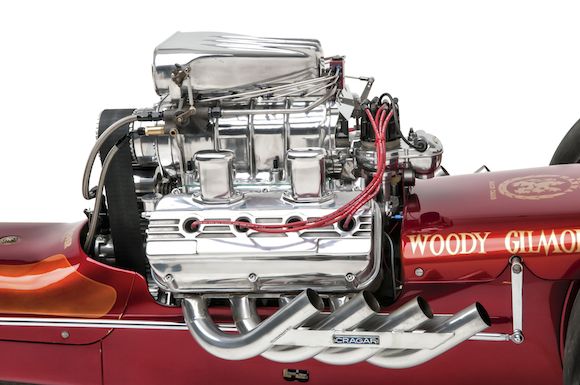
DODGE “RED RAM” HEMI; 1953-1958
Being further down in Chrysler’s pecking order of brands, Dodge didn’t get a Hemi until two years after Chrysler, and one year after Desoto (above Dodge by one notch). When they did, they mixed up the bores and stroked enough to create a wide range of unique displacements so as not to appear to be doing exactly what they were doing: sharing engines across brands. Then named their Hemis “Red Ram” and they were built in displacements of 241, 270, 315 and 325 cubic inches. The high-performance versions got dual 4-barrels on an aluminum intake manifold. Dodge built these engines both with Hemi heads, and with polyspherical heads, to save cost, weight and complexity.
DESOTO “FIRE DOME HEMIS”; 1952-1958
Desoto was Chrysler’s ‘upper-middle brand’ in its hierarchy of brands, just below Chrysler, but you’ll notice that they didn’t get their own Hemi until one year after Chrysler. They used a mix of bores and strokes to turn the corporate Hemi V8, into a variety of displacements including 276, 291, 330, 341 and 345 cubic inches. All were called “Fire Dome” engines to further differentiate them from Chrysler’s and Dodge’s “FirePower Hemis”. The top-line Desoto Fire Dome Hemis got dual Carter 4-barrels and made upwards of 345hp.
2nd-GENERATION MOPAR HEMI, “426 Street Hemi” 1965-1971
2nd-GEN MOPAR HEMI BACKGROUND
1964 was a very important year in the American auto industry. It was the year that Pontiac introduced the world’s first Muscle Car, the GTO. It was the year that Ford launched the game-changing Mustang. Chevy created what would become THE most successful muscle car of the 60s, the Chevelle SS, with their all-new big block just one year away. Clearly Chrysler had to do something fast if it were to have any chance of competing in this hot new market. Chrysler always being strong on engineering took a daring approach to leapfrog over the competition, beat the Big Block Chevy to market, and trump its performance. The did it by once again dusting off the Hemi-head technology developed during World War 2 and through the 1950s, to create a whole new engine. This time, they had much more to work with, including far better metallurgy, casting and forging techniques. What came out of it was the legendary 426 Hemi, and it did just what it was intended to do.
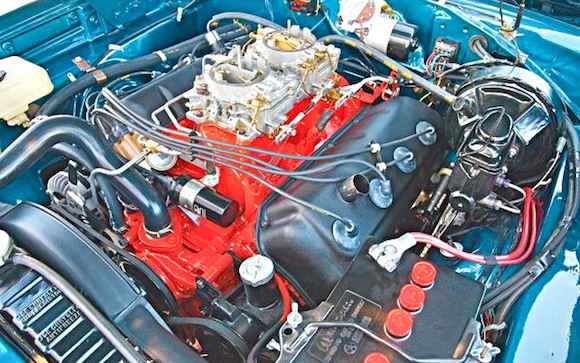
426 HEMI IS “THE ELEPHANT MOTOR”
All 2nd-gen Mopar Hemis are called “Street Hemis”, have a displacement of 426 cubic inches (7.0 liters), are massive engines in both size and weight, and built like a tank. This and the awesome amount of power (425hp) and torque (490 lb-ft) it produced earned it the nickname of “The Elephant Motor” (or Elephant Engine, as you prefer). This came out of the nickname wars of the day. Chevy’s highly-successful small block V8 had been nicknamed the “Mouse Motor”, and so the Chevy big block V8 was called the “Rat Motor”. Since the Mopar Hemi was such a leap ahead of these small rodents, why not go all the way with the animal names? So, instead of being a muskrat only to be outdone by a badger, Chrysler went for it. Or was it the enthusiasts who instantly fell in love with this amazing engine? At the time, it was a very expensive option, and with dual 4-barrels it was terrible on gas and hard to drive slow. So few were ordered, and those that were, were likely raced until they blew apart. Only a total of about 11,000 Street Hemis were built during their 7-year production run, and who knows how many survived.

2nd-GEN MOPAR HEMI IN COMPETITION
The Elephant Motor crushed the competition everywhere it went. From its very introduction, it ruled NASCAR, NHRA and AHRA drag racing. Top Fuelers loved them because they could be bored and stroked out to displacements that were unheard of in other engines, and because of their massive blocks and cross-bolted main caps, they could make huge horsepower and hold together. Hemis loved to be supercharged, and horsepower quickly passed the 1,000-mark. While the horsepower wars were an important consideration in Chrysler showrooms across America, there was fierce competition between the Big 3 in the early 1960s in NASCAR racing. Chrysler’s revolutionary 426 Hemi outclassed the competition to such an extent that Ford complained and got the Hemi banned from NASCAR’s 1965 season on the grounds that it wasn’t truly a production car-based engine, since none had been sold to the public. By the 1966 model year, Dodges and Plymouths were rolling off the assembly lines with (optional, and quite rarte) 426 ‘Street Hemis’. Problem solved the Hemi went back to racing, including powering the now-legendary “Wing Cars”, the 1969 Dodge Daytona and 1970 Plymouth Superbird.
RACE ON SUNDAY, SELL ON MONDAY
So, Chrysler quickly solved that problem by making a civilian version, dubbed “Street Hemi”, with lower compression (reduced to ‘just’ 10.25:1 down from 12.0:1) and a milder cam, and made it available as an option on a wide range of Chrysler products. These included:
* 1966-70 Dodge Coronet/Plymouth Belvedere
* 1966-71 Plymouth Satellite
* 1966-71 Dodge Charger
* 1967-71 Plymouth GTX
* 1968 Dodge Dart SS
* 1968 Plymouth Barracuda SS
* 1968-71 Dodge Super Bee
* 1968-71 Plymouth Roadrunner
* 1969 Dodge Charger Daytona
* 1970 Plymouth Superbird
* 1970-71 Plymouth Barracuda
* 1970-71 Dodge Challenger
426 Street Hemi SPECIFICATIONS
| Engine type
Block & Head material Displacement Bore & Stroke Compression ratio Deck height Bore spacing Fuel system Exhaust Power output Torque output |
OHV 90-degree V8 w/hemispherical combustions chambers
Cast iron 426 cubic inches / 7.0 liters 4.25″ X 3.75″ / 107.95mm X 95.25mm 10.25:1 10.72″ / 272.3mm 4.80″ / 121.9mm 2 Carter AFB carburetors, aluminum intake manifold Cast iron headers 425 bhp (gross); 350 bhp (net, 1971) 490 lb-ft |
3rd-GENERATION MOPAR HEMI, 2003-present
3rd-GEN MOPAR HEMI ISN’T A HEMI
The combustion chambers in the modern Mopar Hemi are no longer hemispherical. So, technically it’s not a true hemi. But, who cares, right? Modern Hemis are doing all the heavy work at Dodge and Ram, in everything from trucks and SUVs, to Jeeps to Challengers, Chargers and Chrysler 300s, making all the way up to 707 supercharged horsepower and beyond! Stock off the showroom floor!! With a warranty!!! The modern-day Mopar Hemis are technological marvels in many ways, despite their old-school pushrod design.

3rd-GEN MOPAR HEMI DESIGN
Instead of a true hemispherical combustion chamber, the modern Hemi has a shallower chamber with the valves at a narrower included angle, relative to one another. This drastically narrows the cylinder head, which is one of the first things you notice, when comparing them to a 426 Hemi. The spark plugs still protrude from the centers of the valve covers, just like the old days, but that’s only one of them. There are 2 spark plugs per cylinder situating the spark plugs ideally to promote a fast flame front and clean burning. They are coil-on-plug with a distributorless ignition system. The earliest versions of the new Hemi were all 5.7 liters, approximately the same displacement as the FirePower Hemi of the 1950s. They started out making 357 horsepower, but soon was up to 389 hp and 410 pound-feet of torque. Later versions got VVT (Variable Valve Timing) for power and a reported 4% boost in fuel economy. Next came MDS (Multi-Displacement System), a cylinder-deactivation scheme that turned it into a V6 under light loads, again aimed to improve gas mileage.
5.7 LITER, 2003-PRESENT
The first of the modern-day Mopar Hemis started life in 2003 as a Dodge Truck engine in the Ram 1500, 2500 and 3500 series, slowly replacing the 5.9 Magnum V8 (the new Hemi made exactly 100hp more than the 5.9). The new 5.7 Hemi eventually spread across the entire V8 produce-line, including the Dodge Durango, Jeep Grand Cherokee, Dodge Magnum, Chrysler 300, Charger and Challenger:
* 2003-present Ram Pickup
* 2004-present Dodge Durango
* 2005-present Chrysler 300
* 2005-2008 Dodge Magnum
* 2005-present Dodge Charger R/T
* 2005-present Jeep Grand Cherokee
* 2006-2010 Jeep Commander
* 2007-2009 Chrysler Aspen
* 2009-present Dodge Challenger R/T
5.7-liter HEMI V8 SPECIFICATIONS
| Engine type
Block/Head material Displacement Bore & Stroke Compression ratio Fuel system Ignition system |
OHV 90-degree V8
Cast iron / aluminum 5654cc (5.7L) / 345 ci 3.917″ X 3.578″ / 99.49mm X 90.88mm 9.6:1 Sequential port electronic fuel injection 2 coil-on-plug/cylinder, distributorless ignition |
2009 REVISIONS TO THE 5.7 HEMI
Significant revisions were made to Chrysler’s entire family of modern Hemi engines in the quest for better performance, fuel economy an emissions. VCT (Variable Cam Timing) replaced VVT, which now used an oil-driven cam phasing system built into the camshaft sprocket to advance and retard cam timing. To improve flow, both the intake manifold and cylinder heads were revised. Some truck and SUV engines got a 2-way active intake manifold with both short and long runners controlled by a set of valves, to maximize low-end torque (with the long runners) and high-rpm performance (with the short runners). But the big news in 2009 wasn’t the revised Hemi, it was the arrival of the all-new Dodge Challenger, and that would require some hotter versions of the Mopar Hemi. The 5.7 that was used in the 2009 Challenger R/T was tuned to make 375 hp, and it came standard with a new 6-speed manual (or a 4-speed auto). The 5.7 Hemi proved to be very easy to tune to fill its many roles and applications. Below is a list of all the different horsepower ratings of the 5.7 Hemi from its revision in 2009 until the present:
* 360hp – Dodge Durango, Jeep Grand Cherokee & Commander
* 363hp – Chrysler 300C
* 370hp – Charger R/T
* 372hp – Challenger R/T automatic
* 375hp – Challenger R/T 6-speed
* 376hp – 2009 Chrysler Aspen & Dodge Durango non-HEV
* 383hp – Ram 2500/3500
* 390hp – 2009-12 Dodge Ram 1500
* 395hp – 2013+ Ram 1500
* 399hp – 2009 Chrysler Aspen & Dodge Durango HEV

6.1-liter MOPAR HEMI, 2005-2010
The 6.1L was the high-performance engine option, and the standard engine in all SRT-8 products during the 6 years of its production, 2005-2010. The increased displacement was achieved through an increase in bore to 4.055″ and leaving the bore alone, yielding a displacement of 6,059cc (6.1L). While very similar, the 6.1 has a different engine block than the 5.7. The 6.1 has revised coolant passages in the water jacket, oil jets to cool the pistons. They ran a forged steel crankshaft with high-strength connecting rods and lightweight pistons. The 6.1 was considered a high-performance engine, and so never received the variable-length intake or the Multi-Displacement System. The 6.1 was discontinued after the 2010, replaced as the optional high-performance engine, by the 6.2L. During that short time span, the 6.1 Hemi appeared in the following models:
2005-2010 Chrysler 300C SRT-8
2005-2008 Dodge Magnume SRT-8
2006-2010 Dodge Charger SRT-8
2006-2010 Jeep Grand Cherokee SRT-8
2008-2020 Dodge Challenger SRT-8
6.2-liter HELLCAT, 2015-present
IN 2015, Dodge introduced a supercharged version of the modern Mopar Hemi engine that produced 707 horsepower right out of the box! They named it “Hellcat” (honoring the WW2 Grumman F6F Hellcat fighter plane), and dropped it first into the Challenger, creating a new model, the Challenger SRT Hellcat. Following its success there, next to receive this awesome powerplant was the Charger SRT Hellcat and the Jeep Grand Cherokee SRT Trailhawk. The accomplished the 6.2L displacement by using the 4.090″ bore of the 6.4, and the 3.578″ stroke of the 5.7, for an actual displacement of 6,166cc (376.3 ci). Most of its prodigious power gain was achieved through a 2,380cc Roots-type IHI twin-scroll supercharger mounted low in the engine valley. It produced 11.6 psi of boost, which pumped through liquid-to-air charge coolers built into the body of the supercharger, making a very compact package. With a 9.5:1 compression ratio, the 6.2 Hellcat produces 707 bhp and 650 pound-feet of torque, making it not only the most powerful production car engine that Chrysler ever produced, the Hellcat was THE most power engine EVER put into a muscle car of ANY kind…that is until they came out with the 6.2 Demon…
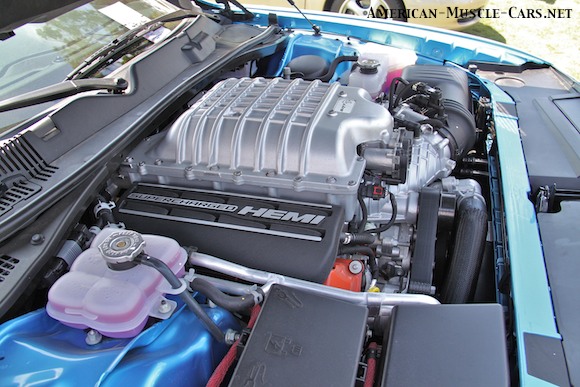
6.2-liter DEMON, 2018-present
As if 707hp wasn’t enough, Chrysler took this already wicked engine and tweeked it some more to produce a whopping 808hp on 91-octane pump gas. Holy crap!! Most of the power gain came from a larger 2.7-liter supercharger and charge-cooler setup, a hotter cam, and stronger internals to cope with all that power. But wait…if you can get your hands on some 100-octane Av Gas, this monster will deliver 840 horses, again and again and again. You see the Demon is not intended to be a stoplight terror. It’s designed for dragstrip-only use. Another of the Demon’s secret weapons is a charge-cooler that uses the air conditioning system’s refrigerant to drastically cool the hot air rushing into the engine, a novel use of what used to be purely a luxury item that most muscle car owners avoided. Now it keeps you cool and makes more power! Ah, those Dodge Boys! The 6.2 Demon is only available in the 2018-and-later Dodge Challenger SRT Demon, which is actually not even street legal. You buy it stripped to the bone, with a box of parts in the trunk, like tiny front wheels, and all the stuff you’ll need to go drag racing. The car is even equipped with a line-lock system from the factory (locks the front brakes while freeing the rear wheels to spin on burn-outs) and the industry’s first factory trans-lock (a transmission brake system that locks the automatic in 2 gears at once to hold the car steady at the line). The Demon also has a Torque Reserve Launch System, to make it easier to launch perfectly every time. This is serious stuff, never seen in showrooms before. But again, you can’t buy one and register it for street use. This is a race car.
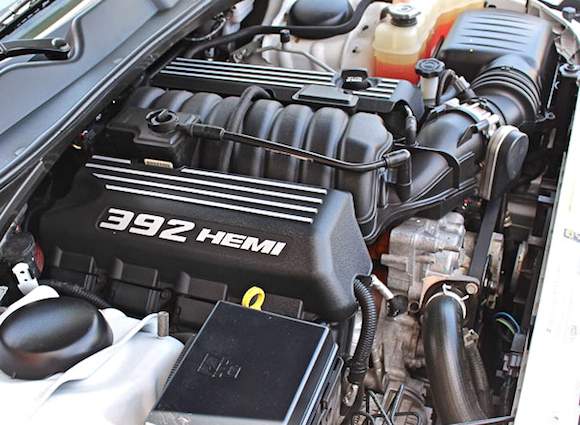
6.4-liter 392 APACHE, 2007-present
While the 5.7 Hemi shared its metric displacement with the 1950’s-era 354 FirePower Hemi, it’s displacement in cubic inches didn’t match at all. The new Hemi had an American displacement of 346 cubic inches, way off from the old-school 354, but somehow it still worked. The new engine established a nostalgic connection to the original Mopar Hemi. For its next act, this new enlarged 6.4-liter Hemi worked out to exactly 392 cubic inches, precisely the same as the old 392 FirePower Hemi. They even bragged out it prominently on the valve covers of the modern engine. This brute was conservatively rated at 485 horsepower and 475 pound-feet of torque, and has the strengthened internals to match. Launched in 2007 as a Mopar crate motor, the 392 Hemi didn’t come out in a production car until the 2011 Challenger SRT8. While similar in almost every way, the car engine shares few parts in common with the crate motor. When equipped with an automatic transmission, the 392 Hemi came with VCT (Variable Camshaft Timing) and MDS (cylinder deactivation) in the interest of fuel economy. The 392 Hemi was either standard or optional in the Charger, Challenger, Jeep Grand Cherokee SRT8, the Chrysler 300SRT8, and all manner of SRT8s, Scat Packs and R/Ts.
HEAVY DUTY 6.4L HEMI, 2014-present
Dodge built a special heavy duty truck version of its hotrod 392 Hemi (above) being completely retuned and optimized for fuel economy, low-rpm grunt, and towing capacity. In this role, it powered the 2014-and-later Ram 2500, 3500, 4500 and 5500 trucks and cab chassis.
MOPAR 426 HEMI PROTOTYPE
At the 2012 North American Detroit International Auto Show, The Dodge Boys displayed a custom show car called the Dodge Charger Redline with a prototype 590hp 7.0-liter (ie: 426 cubic inch) GenIII Mopar Hemi under the hood. Who knows if it will ever reach production. With ever more stringent fuel economy requirements, big V8s of any kind will start going the way of the dinosaurs, and Dodge may not want to make the investment in such a new engine for production, given what may be only a few short years of production.




